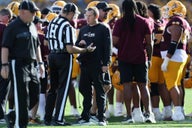After years of struggling over how to stop a trend of faking injuries, college football leaders appear closer than ever to attempting an on-field fix.
The NCAA football rules committee will gather later this month for their annual meeting to discuss potential changes, from overtime timeouts to replay challenge and more. But the topic of “feigning injuries” for clock manipulation or rest purposes is atop the docket. The coaching class that created and exacerbated the problem is trying to fix it — though they don’t all agree.
Advertisement
At last month’s American Football Coaches Association convention in Charlotte, a small committee of coaches came up with an idea: A player removed from a game due to injury must sit out the rest of that drive. If the team trainers and doctors clear a player to return on that drive, a team can use a timeout to “buy” that player back into the game if they’ve sat out at least one play.
“There’s a push by the stakeholders in the game saying, on feigning injuries, something must be done,” Steve Shaw, national coordinator of officials and committee rules editor, told The Athletic. “We can’t kick the can down the road once again.”
The AFCA idea was not presented to the larger group of FBS head coaches who met in Charlotte to discuss and produce their transfer portal change proposal, but the idea will be discussed by the rules committee. Shaw emphasized the AFCA’s specific idea may not be the ultimate result, but the group will debate it.
The biggest pushback from coaches points to quarterbacks. What if they have to come out of a late drive due to a cramp and that team is out of timeouts? It’s a huge personnel loss.
That’s where another idea comes in: to handle differently the “green dot” player — those with a coach-to-player helmet communication, typically quarterbacks and one defensive player. Perhaps they would only have to sit out one play if they’re cleared to return.
After all, quarterbacks aren’t the players faking injuries. They’re not the problem.
“The green dot exception provides a relief from that and makes the rule more palatable,” said Craig Bohl, the AFCA executive director and former Wyoming head coach. “Because the guys abusing this rule and going down are rotational players, not the quarterback.”
The topic of faking injuries has been discussed for years. Small changes haven’t fixed the issue.
Advertisement
In 2022, the rules committee created a new reporting and investigation process, where teams could submit questionable plays to Shaw, who would review it and talk with conferences about potential punishments.
Midway through the 2024 season, SEC commissioner Greg Sankey sent a stern memo to his schools outlining fines and punishments for schools believed to be faking injuries. Ole Miss, regularly accused as a violator by opponents, released a statement in October saying it was in contact with Shaw and the SEC office and providing medical information. Shaw would not confirm if anyone has been punished for faking injuries, leaving that to conferences.

GO DEEPER
Greg Sankey says SEC will fine teams for faking injuries
Whatever has happened, it hasn’t worked. Not long after Sankey’s memo, ESPN’s Chris Fowler and Kirk Herbstreit called out on broadcast what they believed to be a fake injury in Tennessee’s November loss to Georgia.
Kirk Herbstreit and Chris Fowler were pretty sure that Tennessee’s Omarr Norman-Lott was faking this injury.
“He’s right here and looks to be fine. Looking over to the sideline and takes it down.”
“When you look at the sidelines before going down, it’s suspicious.” pic.twitter.com/4UzFJYKcoC
— Awful Announcing (@awfulannouncing) November 17, 2024
To highlight the problem, Shaw put together an eight-minute “highlight” video of plays believed to show players faking injuries, often with a signal from the sideline. He’s shown it to coaches, commissioners and administrators.
“I really thought coming into this season that maybe it was getting better, but after tracking it and putting the video together, it’s not,” Shaw said. “It goes against everything the game stands for. … You get a lot of chuckles, but it’s not a funny thing.”
The idea of having a player sit out a full drive is not new. It’s been dismissed in the past. Shaw has said in prior years that sport’s leaders were concerned a player who was actually injured would try to play through it, so as not to miss the rest of an important drive.
Advertisement
The feeling on that has since changed. Seriously injured players don’t keep themselves in games. The thought is the reward of stopping fake injuries is worth the low risk.
Northern Illinois coach Thomas Hammock, a rules committee member, recounted a recent situation when an NIU player injured his shoulder in practice and played through the pain in a game before NIU coaches told him to go down so he could safely get off the field. Coaches and trainers have to monitor their players, but the disincentivization for players to come out under this idea concerns him.
“You don’t want to jeopardize a young person’s health because they’re trying to push through a situation that may not be conducive for them having success,” he said.
Faking injuries became a larger problem in college football over the past decade because of up-tempo offenses, which aren’t common in the NFL. With each high-profile situation, the sport’s leaders have grown more frustrated. To the point where they feel some on-field solution must happen.
“If somebody’s got a better idea, I’m all for it,” Bohl said. “Coaches have created this albatross around our neck as far as the good of the game. Coaches have created this, and the coaches have come up with a solution for a remedy here.”
Instant replay, coach challenge discussions
Among the other topics the rules committee is expected to discuss include instant replay and the possibility of moving to a coach challenge model like the NFL. It’s been deliberated by the committee in recent years. Coaches have generally been against it because it moves the replay burden to them, and no-huddle offenses make it more difficult for team personnel to look at plays before a challenge compared to the NFL.
Shaw wouldn’t say if it’s any more likely to get out of committee this time, but Division II college football in 2023 added an optional coach challenge model for games where there is not a replay booth official. It’s not unprecedented.
Advertisement
“It’s going to need a lot of discussion,” Shaw said. “This has been a multi-year conversation and it will continue in a way to figure out how we make replay more effective and efficient for our game.”
Overtime timeouts will also be on the docket, with the possibility of not adding new timeouts beyond the second overtime.
The Georgia vs. Georgia Tech game in November that lasted eight overtimes saw three timeouts called during the five periods of the two-point shootout. Multiple bowl games also went to at least five overtimes. Shaw said there is no interest in changing the overtime format, which was created in 2021, but cutting down the additional timeouts to prevent the slowdown of the end of the game will be a point of conversation.
“There was never an intent to get into the basketball situations,” Shaw said, referencing timeouts after teams get in formation. “There will be good discussions around that.”
Smaller topics expected to be debated include substitution mechanics, kickoff return “T” signals, expanding coach-to-player helmet communication to FCS and looking at wearable communication technology like wristbands.
Targeting is a discussion every year, but there is no expectation of any major changes. Shaw said there were 0.14 targeting fouls enforced per game this season, continuing a downward trend. The AFCA has proposed a two-tier targeting penalty model in the past, but there’s little appetite to pull back on targeting when the rule is working, despite a few high-profile spots.
“I’m trying not to be overdramatic, but the targeting rule is saving our game,” Shaw told The Athletic in December. “It is truly changing player behavior.”

GO DEEPER
Targeting is still confusing and contentious. But the NCAA says the penalty is working
(Photo: Mark J. Rebilas / Imagn Images)
This post was originally published on this site be sure to check out more of their content.


